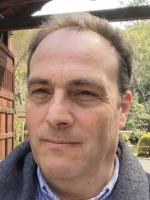
Career
- 2018-date: Royal Society E.P. Abraham Professor, DAMPT, Cambridge
- 2011-date: Herchel Smith Chair in Physics, Cavendish Laboratory,
- Cambridge
- 2002-2010: Personal Chair in the Theory of Condensed Matter, Cavendish Laboratory,
- Cambridge
- 2000-2002: University Readership in the Theory of Condensed Matter, Cavendish Laboratory, Cambridge
- 1995-1999: Lecturer, Cavendish Laboratory, Cambridge
- 1995-date: Fellow, St John’s College, Cambridge
- 1994-1995: Royal Society Research Fellow and Lecturer, Imperial College, London
- 1990-1991: Junior Research Fellow, Gonville and Caius College, Cambridge
Research
Ben is a member the Department of Applied Mathematics and Theoretical Physics and the Cavendish Laboratory, Department of Physics. He also holds affiliated positions in the Wellcome Trust/CRUK Gurdon Institute and the Wellcome Trust/MRC Stem Cell Institute. His research interests have spanned a wide range of topics within the area of theoretical quantum condensed matter physics. However, his current interests are focussed on the application of modelling approaches to study the dynamics of biological systems, from subcellular processes, to cell fate decision-making and morphogenic processes. His research is supported by grants from EPSRC, the Wellcome Trust, CRUK and the Royal Society.
Selected Publications
- S. Rulands, et al., Universality of clone dynamics during tissue development, Nature Physics 14, 469-474 (2018)
- E. Hannezo, et al., A unifying theory of branching morphogenesis, Cell 171, 242-255 (2017)
- X. Lan, et al., Cell fate mapping of human glioblastoma reveals an invariant stem cell hierarchy pre- and post-treatment, Nature 549, 227-232 (2017)
- A. Sanchez-Danes, et al., Defining the clonal dynamics leading to tumor initiation, Nature 536, 298-303 (2016)
- B. D. Simons and H. Clevers, Strategies of stem cell self-renewal in adult tissues, Cell 145, 851-862 (2011)
- C. Lopez-Garcia, et al., Intestinal stem cell replacement follows a pattern of neutral drift, Science 330, 822-825 (2010)
Publications
Troy plus brain stem cells cycle through quiescence and regulate their number by sensing niche occupancy
– Proc Natl Acad Sci U S A
(2018)
115,
E610
(doi: 10.1073/pnas.1715911114)
Muscle Stem Cells Exhibit Distinct Clonal Dynamics in Response to Tissue Repair and Homeostatic Aging.
– Cell stem cell
(2017)
22,
119
(doi: 10.1016/j.stem.2017.11.009)
Emergence and universality in the regulation of stem cell fate
– Current Opinion in Systems Biology
(2017)
5,
57
(doi: 10.1016/j.coisb.2017.08.001)
A Unifying Theory of Branching Morphogenesis
– Cell
(2017)
171,
242
(doi: 10.1016/j.cell.2017.08.026)
Fate mapping of human glioblastoma reveals an invariant stem cell hierarchy.
– Nature
(2017)
549,
227
(doi: 10.1038/nature23666)
Multipotent Basal Stem Cells, Maintained in Localized Proximal Niches, Support Directed Long-Ranging Epithelial Flows in Human Prostates
– Cell Reports
(2017)
20,
1609
(doi: 10.1016/j.celrep.2017.07.061)
Multi-site Neurogenin3 Phosphorylation Controls Pancreatic Endocrine Differentiation.
– Developmental Cell
(2017)
41,
274
(doi: 10.1016/j.devcel.2017.04.004)
Long-term, hormone-responsive organoid cultures of human endometrium in a chemically defined medium.
– Nature Cell Biology
(2017)
19,
568
(doi: 10.1038/ncb3516)
Organoid Cultures of Human Endometrial Glands: A Model for Investigating Early Pregnancy.
– Reproductive Sciences
(2017)
24,
291A
Defining stem cell dynamics and migration during wound healing in mouse skin epidermis
– Nature Communications
(2017)
8,
14684
(doi: 10.1038/ncomms14684)
- <
- 12 of 31
